About CLASH Analyst
Using CLASH Analyst
What is CLASH?
Non-coding RNAs, such as miRNAs and piRNAs, are regulatory RNAs that play a critical role in controlling gene expression through base pairing interactions with their RNA targets. The recent development of the CLASH (crosslinking, ligation, and sequencing of hybrids) method has allowed scientists to identify in vivo targets of regulatory RNAs. CLASH experiments start with capturing RNA-protein complexes in vivo followed by a ligation step to fuse a regulatory RNA to its target RNA in its proximity in the cell (see the picture below). As a consequence, the transcriptome-wide RNA-RNA interactions between regulatory RNAs and target RNAs can be identified by examining chimeric reads obtained from high throughput sequencing which consist of fragments of regulatory RNAs and their target RNAs.
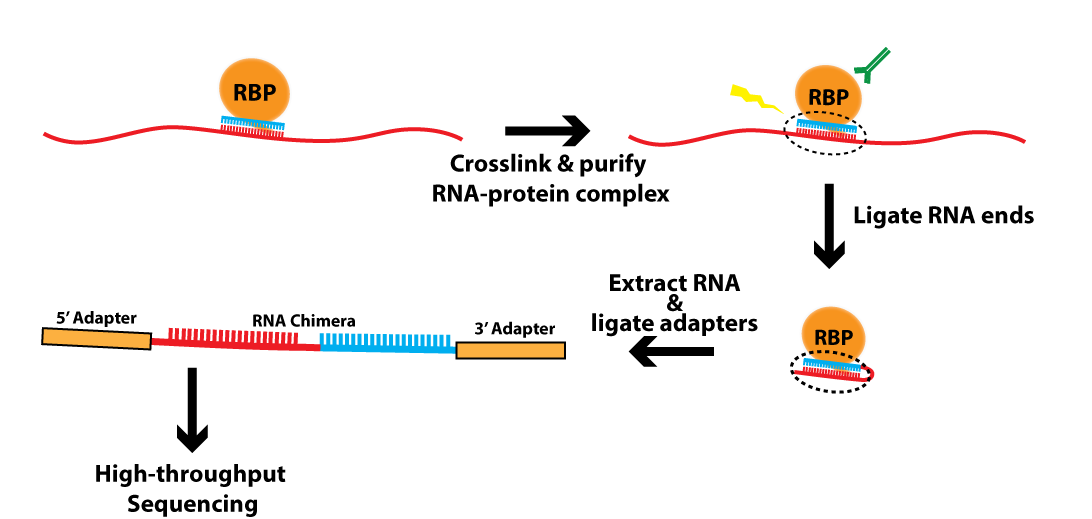
Motivation of developing CLASH Analyst
To date, over 1000 distinct miRNAs have been found in humans and ~50 percent of human genes are estimated to be regulated by miRNAs. Recent studies have shown that an even more prevalent regulatory RNA called piRNAs (>1 million in mice) can regulate diverse mRNA targets. Therefore, biologists in diverse fields will be interested in the RNA targets of miRNAs and piRNAs identified from CLASH data. However, analyzing CLASH data requires scientists to use advanced bioinformatic skills. In addition, many published CLASH studies focus on specific aspects of the data (or present only small selections from the data) rather than reveal the full scope of RNA-RNA interactions that were captured, highlighting the value of reanalyzing published data. We therefore develop CLASH Analyst to allow scientists with and without bioinformatic knowledge to perform integrative analysis of CLASH data.
Impact of CLASH Analyst
CLASH Analyst is the first webserver that can analyze raw CLASH data within a fully customizable and easy to use interface. CLASH Analyst accepts raw CLASH data as an input and identifies the RNA chimeras containing regulatory RNAs and their target RNAs. Users can fine-tune each step in the analysis pipeline directly within the interface. Detailed annotation of the captured RNA-RNA interactions, such as binding energy, base-paring position, and read counts are all presented for users to visualize within the server or download for further analysis. We showed that CLASH Analyst can effectively identify miRNA and piRNA targeting sites reported from published CLASH data.
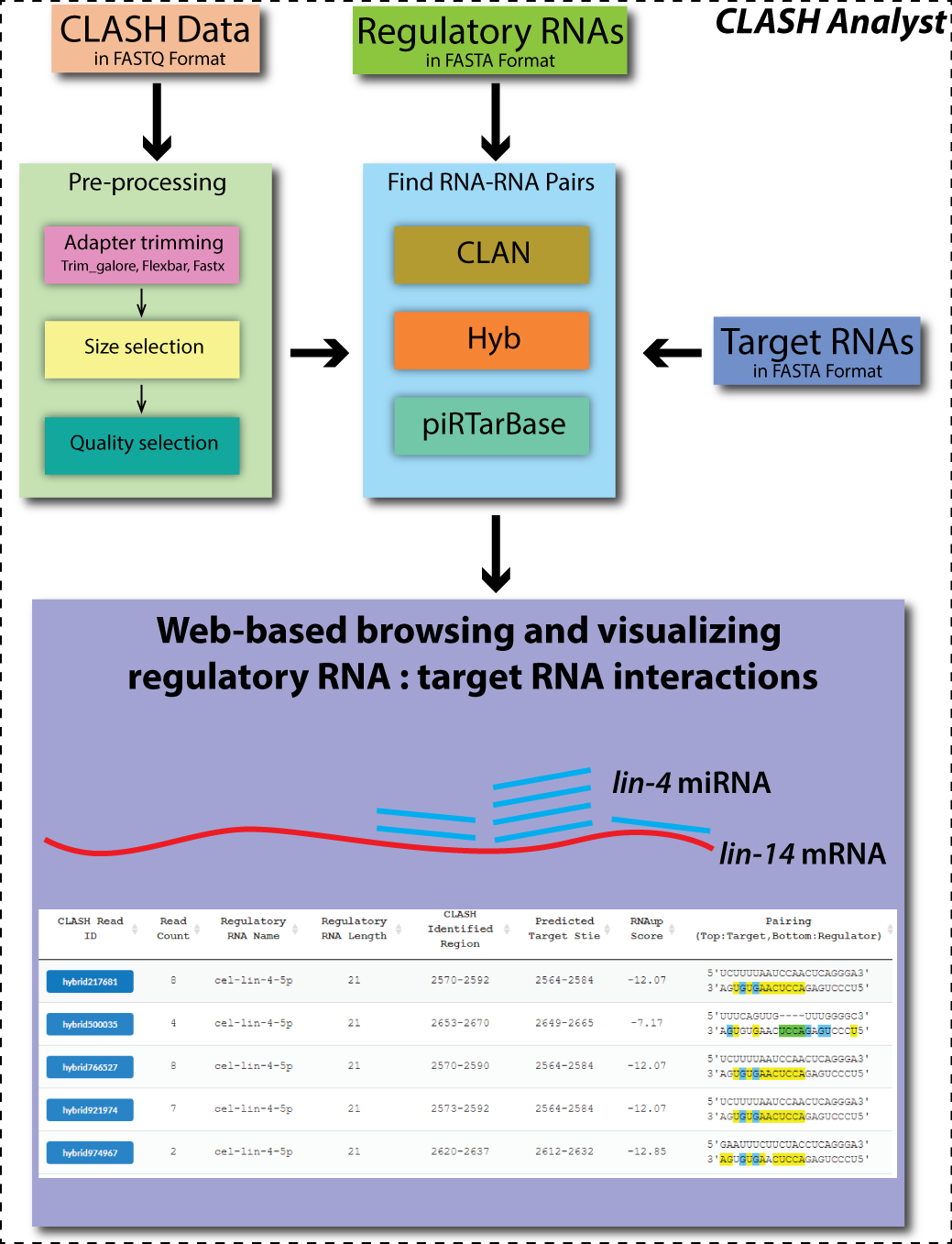
Example Quick Start
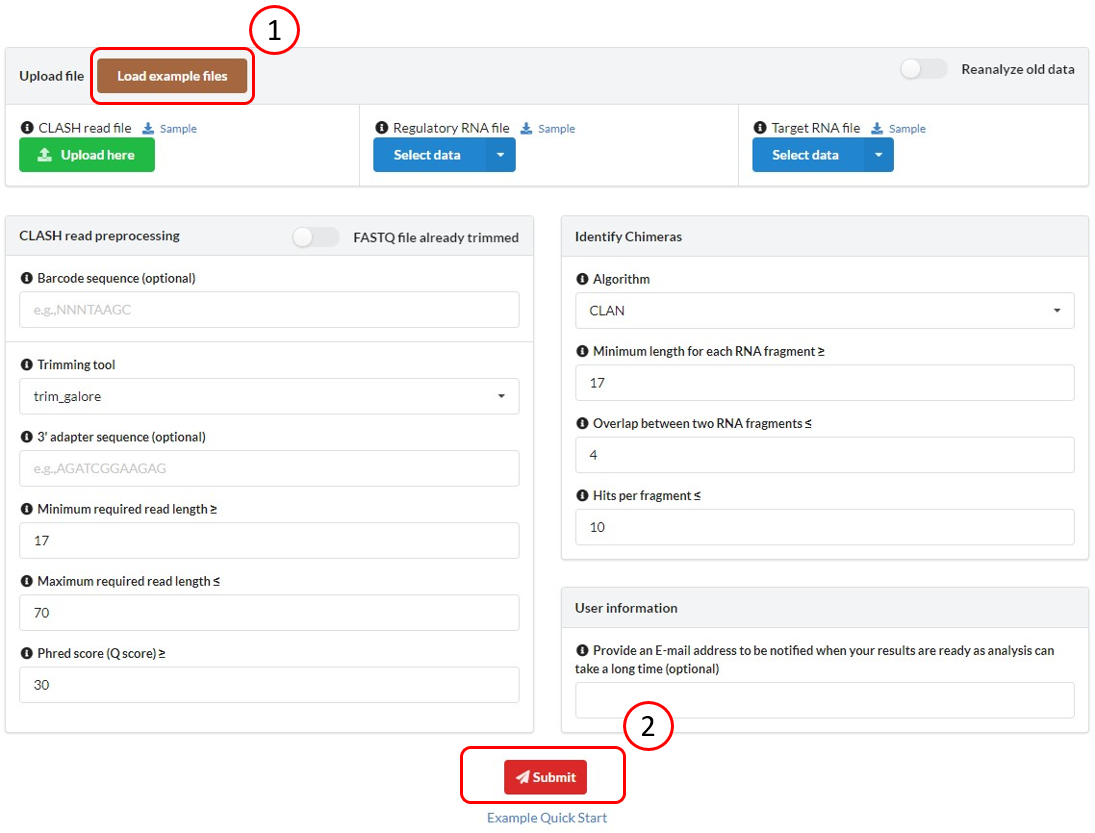
To analyze example data:
1. Load the example data by clicking Load example files
2. Click Submit at the bottom of the Input page
3. When submission completes (~5 seconds), you will be redirected to a new page:

4. Press Show Results after the analysis completes (~20 seconds). If the results are not available, then you can simply try again after a couple seconds.
5. You can now browse the results
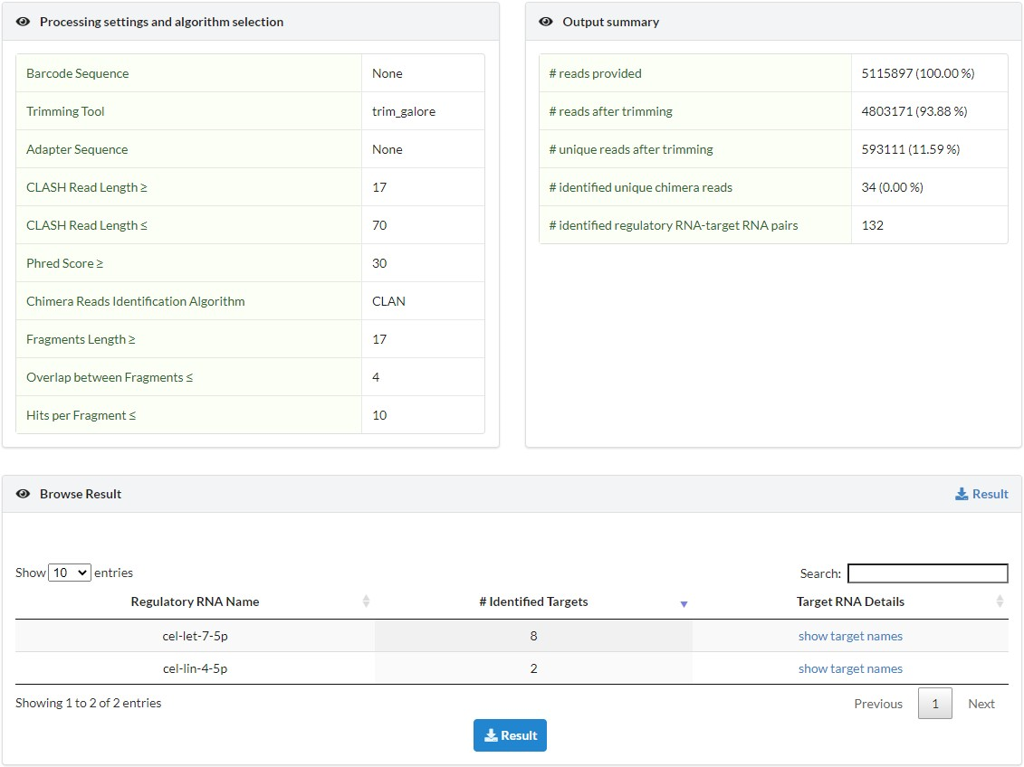
Input page
1. Upload three files, including CLASH raw reads, regulatory RNA sequences, and target RNA sequences.
Common regulatory RNA sequences (e.g. human miRNAs, C.elegans miRNAs, C.elegans piRNAs) and target RNA sequences (e.g. human mRNAs, C.elegans mRNAs) are pre-loaded and can be selected by the user using a drop down menu to skip uploading/downloading these data.
2. Set parameters for CLASH read preprocessing.
CLASH Analyst will perform all necessary steps to preprocess the raw reads (including adaptor/barcode sequence removal and reads quality control etc.) so that chimeras can be identified. The user can choose default settings or select specific settings according to how the CLASH libraries were prepared.
3. Select one chimera identification algorithm and set parameters.
The user can choose between 3 different algorithms to assign chimeric reads: CLAN, Hyb, and piRTarBase. The default searching tool in CLASH Analyst is CLAN, as it is a powerful searching tool that will identify more comprehensive chimeric reads than the other two tools. However, Hyb and piRTarBase typically identify chimeric reads with more stable pairing.
4. Provide e-mail address (optional).
The analysis can typically take a few hours to run (sometimes a day for larger datasets), so we have provided an option for the user to input an email address for the user to be notified once the analysis is complete.
5. Click "Submit".
Once the user has uploaded all data and selected all necessary settings, they can submit the analysis job by pressing submit at the bottom of the page. A Job ID and a website link are provided for the users to check the status and examine the results.
Click here to submit a sample input.
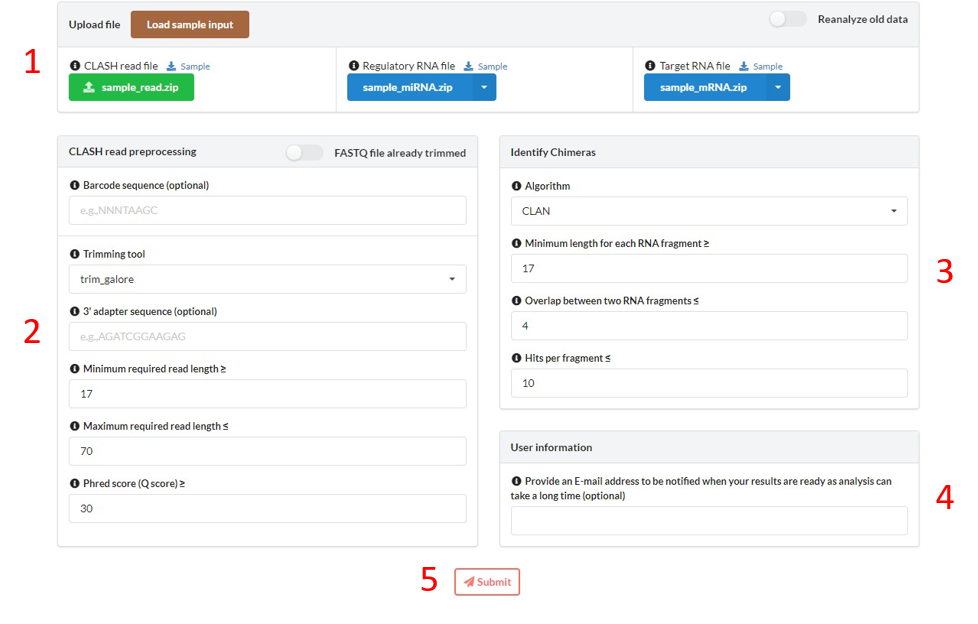
Output page
1. Output page contains two summary tables.
A summary of the analysis is first displayed in two tables. The first table (left) shows all the user-specified settings that were used to perform the analysis. The second table (right) shows the number of various reads identified by CLASH Analyst, including (1) the number of reads provided by the user, (2) the number of reads and unique reads after trimming the adaptors, (3) the number of those trimmed reads that were identified as chimeric, and (4) the number of RNA-RNA interactions identified.
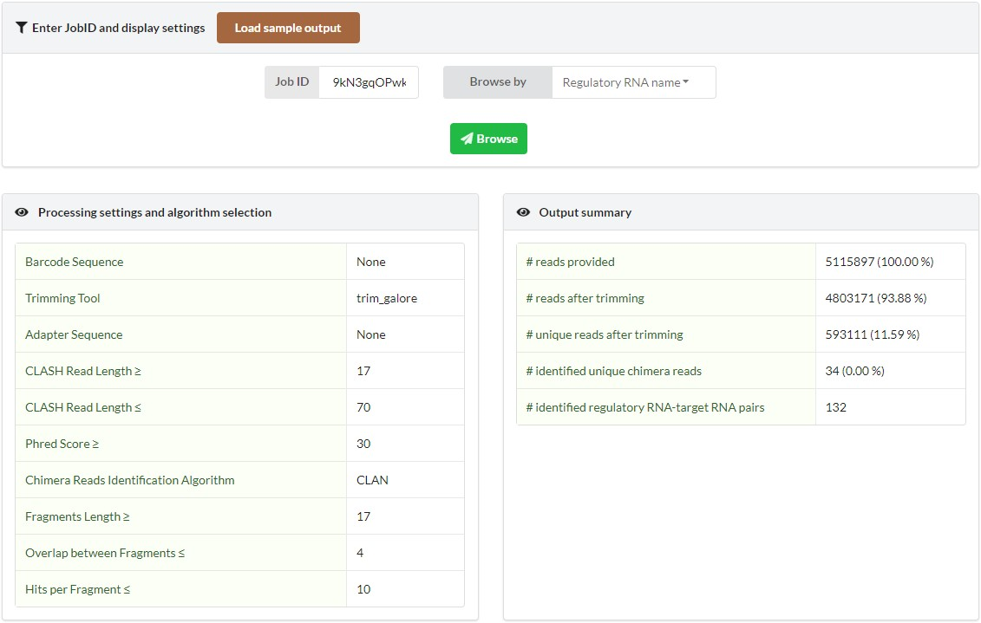
2. We provide three ways to browse the results.
(A) Browse by regulatory RNA names
1st layer: Show the number of identified target RNAs for each regulatory RNA.
The user can use search function by inputting a specific regulatory RNA name (such as let-7 or lin-4) to examine the number of target RNA candidates identified. Click “show target names” to go to the 2nd layer.

2nd layer: Show the target RNA names of the selected regulatory RNA (e.g. RNAs targeted by the C. elegans miRNA cel-let-7-5p, shown below).
The user can search for specific target RNAs of a given regulatory RNA or sort the list of target RNAs according to the number of unique chimera reads identified. Each regulatory RNA-target RNA pair can be further examined by clicking “show interaction” to go to the 3rd layer.
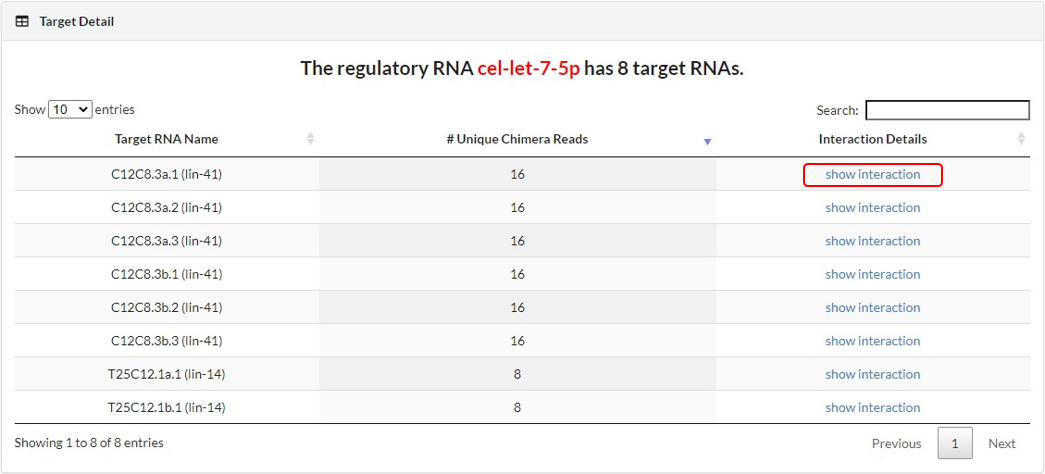
3rd layer: Show all the unique chimera reads for the selected regulatory RNA-target RNA pair (e.g. chimeras containing cel-let-7-5p:C12C8.3a.1, shown below).
A graphic (below) showing the interactions between target RNA and regulatory RNA is available for viewing. Also, a table (below) that shows each identified interaction by chimera reads can be viewed. This table shows detailed information about each hybrid, including the number of reads, the thermodynamic stability of the predicted hybrid, the length of the fragments and where they mapped, and the base pairing between the identified fragments.
Click here to view the interactive results of the regulatory-target RNA pair (cel-let-7-5p:C12C8.3a.1)
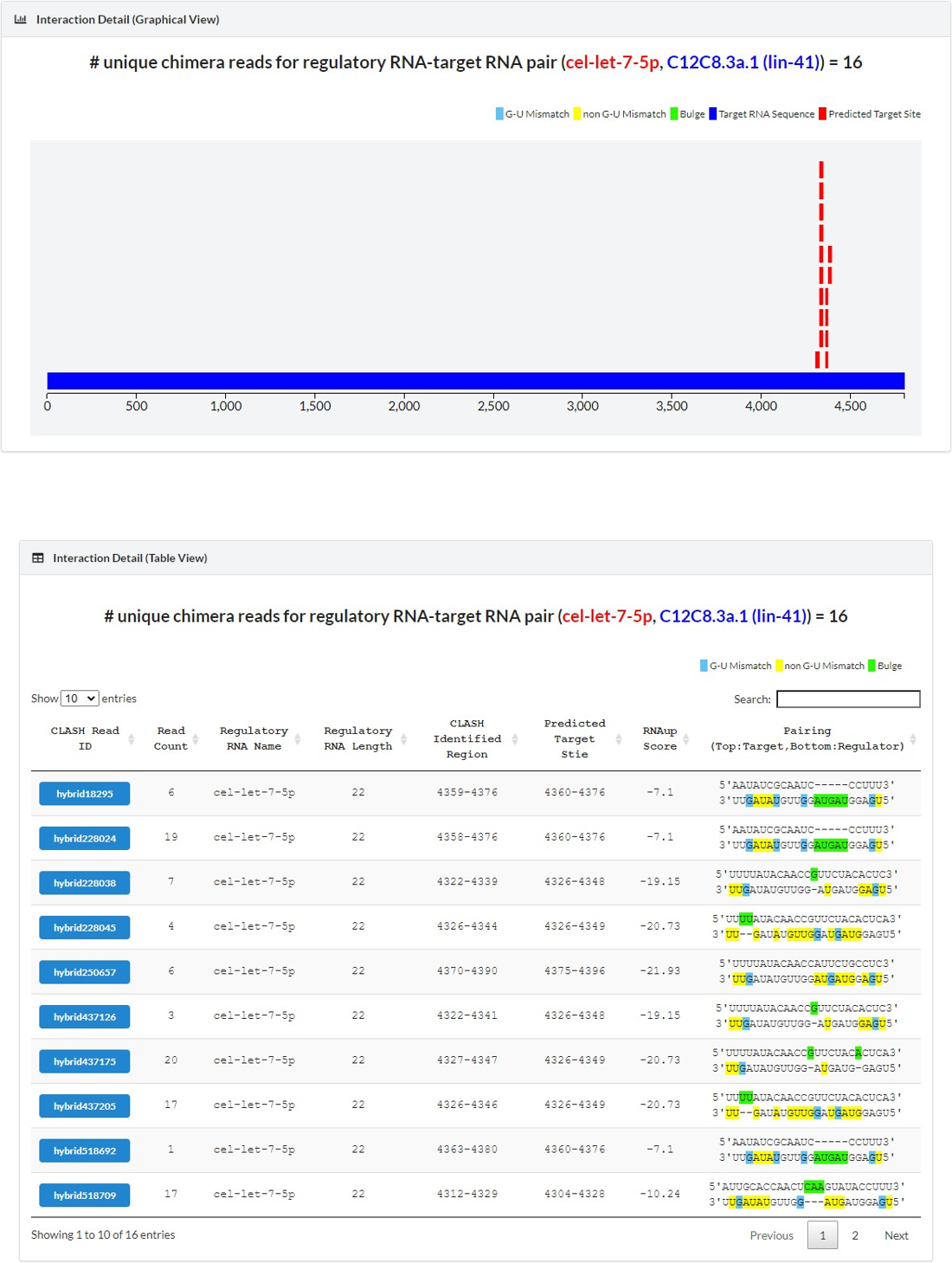
(B) Browse by target RNA names
1st layer: Show the number of identified regulatory RNAs for each target RNA.
The user can use a search function by inputting a specific target RNA (e.g. T25C12.1a.1, the C. elegans lin-14 mRNA) to examine the number of regulatory RNA candidates identified. Click “show interaction” to go to the 2nd layer.

2nd layer: Show all the unique chimeric reads for the selected target RNA
A graphic (below) showing the interactions between the selected target RNA and all the regulatory RNAs which pair with it is available for viewing. Also, a table (below) that shows each identified interaction by chimeric read can be viewed. This table shows detailed information about each hybrid, including the number of reads, the thermodynamic stability of the predicted hybrid, the length of the fragments and where they mapped, and the base pairing between the identified fragments.
Click here to view the interactive results of target RNA (T25C12.1a.1)
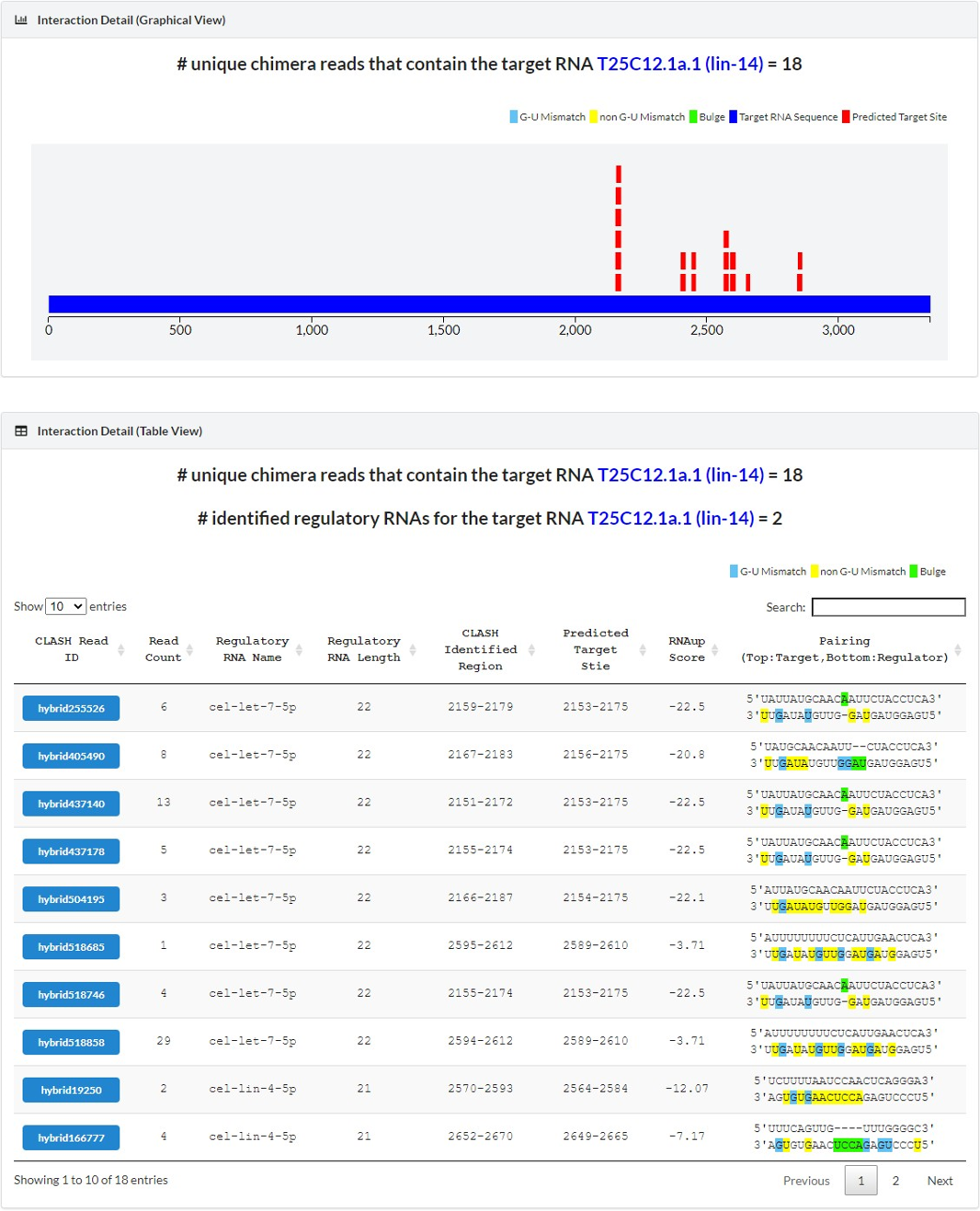
(C) Browse by regulatory RNA-target RNA pairs
The results can either be sorted according to read count or according to most favorable binding energy. The output table will have rows corresponding to each RNA-RNA interaction, and will show information about each hybrid, including the number of reads, the thermodynamic favorability of the RNA-RNA interaction, the length of the fragments and where they mapped, and the base pairing between the identified fragments. The webpage will only show the first 10,000 results. To view the rest, the user can download the full result from the main output page.

Browse compatibility
| OS | Version | Chrome | Firefox | MicrosoftEdge | Safari |
|---|---|---|---|---|---|
| Linux | CentOS 6 | n/a | 84.0 | n/a | n/a |
| MacOS | HighSierra | 87.0 | n/a | n/a | 11.1 |
| Windows | 10 | 87.0 | 84.0 | 87.0 | n/a |
Access the source code at github
The source code of CLASH Analyst can be downloaded at:
https://github.com/t50504/CLASHanalyst